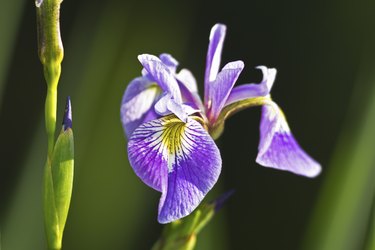
Garden irises (Iris spp.) are in two main iris varieties: bearded and the beardless. Siberian irises (Iris sibirica), the most common beardless variety, are hardy in U.S. Department of Agriculture plant hardiness zones 3 through 9. Bearded irises are hardy in USDA zones 3 through 10, depending on the specific variety and cultivar. Easy perennials to grow, both bearded and beardless irises benefit from proper pruning, which encourages healthy growth and lush flowering while discouraging disease and pest problems.
Iris Pruning Preparation
Video of the Day
The only necessary pruning tool for any iris variety is a set of sharp shears. Wear gloves to protect your hands when cutting back the plants because iris leaves have stiff edges that can cause injury. Before pruning, wipe the shears with a cloth soaked in isopropyl alcohol, and also wipe the shears with isopropyl alcohol after pruning one plant and before pruning another plant, minimizing the spread of plant diseases and pests. Dispose of removed plant material promptly after pruning so the dead leaves and flowers don't provide cover for pests and diseases.
Video of the Day
Iris Deadheading Method
Deadheading irises, regardless of the variety, directs plant energy and nutrients away from seed production and instead helps fuel healthy leaf and rhizome growth, which can result in fuller plants with more flowers the following year. Bearded irises look best with deadheading while the Siberian variety has ornamental seedpods that you may choose to leave in place through fall. Cut back the old flower stems after all the buds on the stems have finished blooming, or in fall if you preserve the stems for ornamental purposes. Cut through each stem at its base, where it emerges from the ground, using the disinfected shears.
Trimming of Foliage
Iris foliage can persist into winter depending on the plants' variety and the temperature. It is OK to cut back the leaves any time after they begin to yellow or become limp. Cut back the foliage of both bearded and Siberian irises to within 6 inches of the ground. Cutting the foliage to ground level is fine if the foliage dies back completely, but avoid cutting into the exposed tops of the rhizomes. Dispose of the foliage after its removal. If your area has long, freezing winters, then cover your iris bed with a 2- to 4-inch-thick layer of mulch to protect the rhizomes and roots from frost heave. In a milder climate, a mulch layer after pruning isn't always necessary.
Tips for Pruning Irises
Although irises primarily require pruning only after flowering and in fall, dead or diseased leaves can be cut out any time of year. Trim back these leaves to their bases to improve the plants' appearance and to prevent the spread of pests and diseases. Cutting out foliage affected by iris leaf spot fungus or shoots infested with verbena bud moth larvae, which have yellow-green, wormlike bodies with black heads, prevents these problems from spreading. If you dig up and divide your irises, then it also is necessary to prune back the foliage to a 6- to 8-inch height before you remove the rhizomes from the ground.